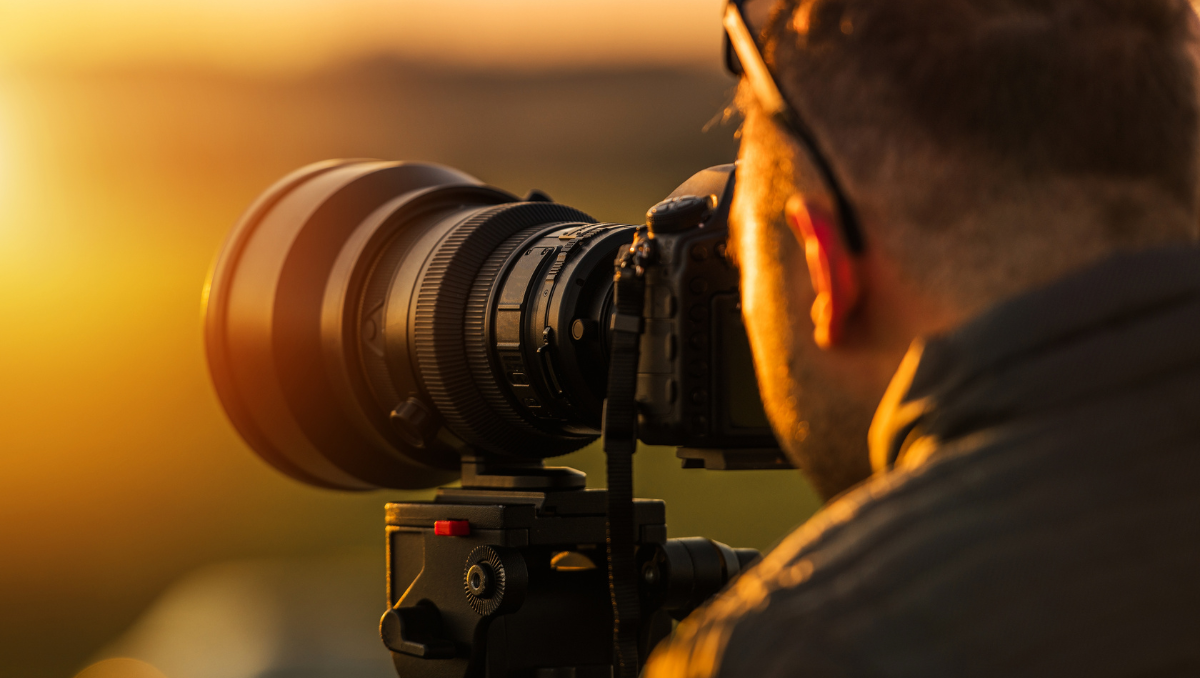Photography is a visual art that captures moments, emotions, and stories through images. Benefits of photography extend far beyond mere documentation. The practice allows for self-expression, preserves memories, fosters creativity, and serves as a powerful communication tool.
In this blog, we’ll explore the myriad benefits of photography, uncover its advantages, delve into its potential drawbacks, and examine the multifaceted role it plays in our lives and society. Whether it’s freezing a moment in time, communicating messages, or expressing emotions, photography offers a unique perspective on the world around us.
Table of content
- Key Benefits of Photography
- Advantages and Disadvantages of Photography
- Advantages of Photography
- Disadvantages of Photography
- How to Get into Photography
- Types of Photography
- Scope of Photography India
- Salary in Photography in 2025
- Top 5 Courses for Photography
- Conclusion
- FAQs
Key Benefits of Photography
Whether you’re a budding photographer or simply exploring the art form, photography offers far more than just beautiful images. From self-expression to career-building, the benefits of professional photography, the basics of photography, and photography for students extend into personal growth, creativity, and even mental wellbeing.Encourages Mindful Awareness
Photography requires you to be fully present in the moment. When you’re composing a shot, you’re not rushing—you’re slowing down to truly observe your surroundings. This act of focusing on small details, like how sunlight hits a leaf or the expression on someone’s face, promotes mindfulness and helps reduce daily distractions.Nurtures Creative Thinking
Professional photography is a creative pursuit that pushes you to see the world from different angles—literally and figuratively. Whether you’re experimenting with framing, depth of field, or color, the process encourages you to think innovatively and develop your unique visual style.Supports Personal Expression
One of the biggest benefits of photography for students is that it becomes a powerful outlet for self-expression. Through photography, individuals can communicate feelings, stories, or perspectives they might find difficult to share in words. It’s a visual language that’s personal and deeply impactful.Cultivates Observational Skills
Photographers notice things others might miss—patterns in architecture, the glow of sunset light, or candid human emotions. Regular practice hones your observational abilities, which is especially helpful for students developing critical thinking and attention to detail.Promotes Light Physical Engagement
While photography isn’t physically intense, it naturally encourages movement. Whether you’re hiking to get a landscape shot, wandering city streets for candid photography, or adjusting lighting equipment, it keeps you physically active without it feeling like a chore.Builds Social Connections and Belonging
Joining photography groups, clubs, or participating in photo walks introduces you to like-minded creatives. These communities offer feedback, encouragement, and networking opportunities—essential for those pursuing professional photography or simply seeking a creative peer circle.Captures Meaningful Moments
Photography gives you the incredible ability to freeze time. For students, it can mean capturing school milestones; for professionals, it can be about documenting life-changing moments for clients. These visual memories become valuable keepsakes that hold emotional significance.Relieves Stress and Enhances Wellbeing
Many people find the act of taking photos relaxing. The focus required in photography often acts as a break from stress, allowing you to immerse yourself in the creative process. This makes photography a therapeutic hobby that supports emotional health.Inspires New Perspectives
Looking through a lens changes how you see the world. EverydayAdvantages and Disadvantages of Photography
Here’s a detailed overview of the advantages and disadvantages of photography:Advantages of Photography
Here are some benefits of photography:- Preservation of Memories: Photography allows moments to be frozen in time, creating a tangible record of memories that can be cherished for generations.
- Creative Expression: It serves as a medium for creative expression, enabling photographers to convey emotions, stories, and perspectives through visual imagery.
- Documentation and Communication: Photos are powerful tools for documenting events, conveying messages, and communicating ideas effectively.
- Professional Opportunities: It offers various professional avenues such as commercial, portrait, wedding, wildlife, fashion, and landscape photography, creating career prospects for enthusiasts.
- Artistic Exploration: Photography is an art form that encourages exploration, experimentation, and the development of a unique visual style.
- Therapeutic Benefits: Engaging in photography can be therapeutic, reducing stress, enhancing mindfulness, and promoting mental well-being.
Disadvantages of Photography
Here are the disadvantages if photography:- Expensive Equipment: Quality photography equipment can be costly, making it a barrier for beginners or those with budget constraints.
- Technical Skill Required: Mastering the technical aspects of photography, such as exposure, composition, and post-processing, requires time and dedication.
- Dependence on Technology: Reliance on technology exposes photographers to equipment malfunctions, data loss, and the need for constant upgrades.
- Competitive Industry: The field of photography is highly competitive, requiring photographers to stand out among a sea of talented individuals.
- Copyright and Intellectual Property Issues: Photographers face challenges related to copyright infringement and protection of their intellectual property.
- Ethical Concerns: Photography raises ethical questions regarding privacy, consent, and the responsible use of images, especially in the digital age.
How to Get into Photography
Entering the field of photography involves several steps and considerations:- Understand Photography Basics: Start by learning the fundamentals of photography, including camera handling, exposure settings, composition, lighting, and post-processing. Online tutorials, workshops, books, and courses can help in acquiring these foundational skills.
- Invest in Quality Equipment: While having high-end gear isn’t a prerequisite, having a decent camera and essential lenses suitable for your chosen genre is essential. Explore different camera types, lenses, tripods, and accessories based on your budget and requirements.
- Practice Consistently: Experiment with various photography genres to find your niche. Engage in regular practice sessions, explore different environments, and learn from both successes and failures. Developing a unique style comes with continuous practice.
- Education and Training: Consider formal education or specialized courses in photography. Many universities, colleges, and institutes offer photography programs covering technical skills, artistic aspects, and industry insights.
- Build a Portfolio: Assemble a portfolio showcasing your best work across different genres. A strong portfolio is crucial when seeking opportunities or clients and demonstrates your skills and style to potential employers or customers.
- Networking and Collaboration: Connect with other photographers, join photography communities, attend workshops, and participate in exhibitions or competitions. Networking helps in gaining exposure, learning from others, and finding potential collaborations or job opportunities.
- Assist Established Photographers: Working as an assistant to professional photographers provides valuable hands-on experience, exposure to the industry, and insights into the practical aspects of photography.
- Market Yourself: Create a professional online presence through a website or social media platforms to showcase your portfolio. Additionally, consider offering your services for events, freelance projects, or collaborations to gain exposure and experience.
Types of Photography
Photography comprises numerous genres, each with its unique characteristics, techniques, and purposes. Here are some of the prominent types:- Portrait Photography: Focuses on capturing the personality, mood, or expression of an individual or a group. It involves controlling lighting, composition, and posing to convey the subject’s essence.
- Landscape Photography: Concentrates on capturing nature’s beauty, including vast landscapes, mountains, seascapes, and natural environments. It often involves using wide-angle lenses and understanding natural lighting to create compelling compositions.
- Macro Photography: Involves capturing extreme close-ups of small subjects like insects, flowers, or tiny details. It requires specialized equipment to achieve high magnification and sharp focus on minute details.
- Street Photography: Captures everyday life, candid moments, and public scenes in urban settings. It focuses on documenting moments as they happen, often without the subject’s knowledge, to convey the authenticity of the environment.
- Fashion Photography: Centers on showcasing clothing, accessories, or fashion trends. It involves working with models, stylists, and makeup artists to create visually appealing and evocative images.
- Wildlife Photography: Involves capturing animals, birds, and their natural behaviors in their habitats. It demands patience, technical expertise, and specialized equipment for shooting from a distance.
- Architectural Photography: Focuses on capturing buildings, structures, and interiors. It emphasizes clean lines, angles, and compositions to showcase the design and beauty of architectural spaces.
- Documentary Photography: Aims to chronicle events, cultures, or social issues to inform, raise awareness, or evoke empathy. It often tells stories through a series of images.
Scope of Photography India
The scope of photography in India has expanded significantly in recent years due to several factors:- Commercial Opportunities: Photography has gained substantial commercial importance in various industries. From e-commerce to advertising, real estate, food, fashion, and travel, the demand for high-quality visual content has surged, opening avenues for professional photographers.
- Social Media and Digital Marketing: With the rise of social media platforms, businesses and individuals are constantly seeking visually appealing content to engage their audience. This has amplified the need for skilled photographers who can create compelling visuals for online platforms.
- Wedding and Events: In India, weddings and events are grand and often require comprehensive photography coverage. This sector has seen significant growth, offering numerous opportunities for wedding and event photographers.
- Tourism and Travel: India’s rich cultural heritage and diverse landscapes make it a paradise for travel photographers. The tourism industry constantly seeks captivating images to promote destinations, driving the demand for skilled travel photographers.
- Editorial and Documentary Work: Documentary photography and photojournalism play crucial roles in storytelling. They capture social issues, cultural nuances, and current events. Several publications, both digital and print media, require powerful images to accompany articles and news stories.
- Fine Art and Exhibitions: The appreciation for photography as a fine art form has grown. There’s a burgeoning market for photographic prints and exhibitions in galleries and art festivals, creating opportunities for artists to showcase their work.
- Educational Institutes and Workshops: Photography education and workshops have gained momentum. Numerous institutes and workshops cater to aspiring photographers, providing them with the skills and knowledge required to excel in the field.
- Stock Photography and Licensing: Online stock photography platforms offer opportunities for photographers to sell their work through licensing, providing a continuous revenue stream.
Salary in Photography in 2025
Sure, in a general sense, the salary for photographers in India can vary based on several factors. Entry-level positions or freelance work might yield anywhere between ₹2-5 lakhs per annum. With experience and a solid portfolio, mid-level photographers can earn around ₹5-10 lakhs annually. Established professionals or those specializing in specific niches like fashion, commercial, or advertising photography might earn upwards of ₹15-20 lakhs or more per year. However, these figures can significantly fluctuate based on individual expertise, clientele, location, and the type of photography pursued.Top 5 Courses for Photography
Here are five prominent photography courses that aspiring photographers might consider:- AAFT Online’s Comprehensive Photography Course: Known for its comprehensive approach covering various photography genres, techniques, and post-production skills.
- National Institute of Photography: Offers diploma and certificate courses focusing on different aspects of photography, including photojournalism, fashion photography, and more.
- Light & Life Academy: Renowned for its professional photography courses covering subjects like travel, wildlife, and commercial photography.
- Delhi College of Photography: Provides diploma and short-term courses in photography, emphasizing both technical and artistic aspects.
- Asian Academy of Film & Television (AAFT): Offers diploma and degree courses with a focus on practical training, digital imaging, and diverse photography genres.
Conclusion
In the vibrant canvas of visual storytelling, photography stands as a versatile tool, offering individuals a gateway to capture moments, express creativity, and communicate narratives. The benefits of photography extend beyond the mere act of clicking pictures; it encompasses self-expression, memory preservation, and professional avenues. However, it’s essential to acknowledge that along with its myriad advantages, photography also presents challenges. Understanding the nuances, including technical skills, artistic expression, and the changing landscape, is vital for aspiring photographers. Grasping the advantages and disadvantages of photography empowers enthusiasts to harness its potential, navigating the evolving realms of this captivating art form.FAQs
1.What are the benefits of photography?
The benefits of photography are wide-ranging. It boosts creativity, improves focus, reduces stress, and helps you express your personality and emotions visually. Whether you’re capturing nature, portraits, or everyday life, photography teaches you to notice details and appreciate the world more deeply.2.What are the benefits of photography as a hobby?
Taking up photography as a hobby can offer relaxation, purpose, and a break from screen time. One of the major benefits of photography as a hobby is that it encourages mindful living and observation. It’s also a great way to connect with communities and share your perspective with others.3.What is so important about photography?
Photography plays a vital role in how we document history, tell stories, and communicate. One of the most important benefits of professional photography is its ability to capture moments with precision, style, and emotion—making it essential for industries like media, marketing, fashion, and events.4.What are 5 facts about photography?
- Photography improves visual literacy and helps develop a creative eye.
- The benefits of photography for student life include enhanced project work, better presentation skills, and a stronger creative portfolio.
- Professional photographers often use light, angles, and editing tools to create high-impact visuals—showing the real benefits of professional photography.
- Photography helps preserve memories and milestones for generations.
- It’s a field that combines art and technology, offering career opportunities across media, design, journalism, and more.
(Visited 9,467 times, 6 visits today)
Popular Search
Top 10 DJ India
Makeup Steps
Advantages of Makeup
Interior Designer Salary
Makeup Artist Course
Benefits Of Photography
Hospital Waste Management
Types of Fashion Designing
Types of Lenses in Photography
How to Become a Radio Jockey
Best Nutrition Courses in India
Importance of Media Management
How To Become a Dietitian in India
Importance of Nutrition in Health
Interior Design History and Origins
Top 10 Famous Interior Designers
Top 10 Music Labels in India
Top 10 Best Animation Studios in India
Top 10 Nutraceutical Companies in India
Top 10 Fashion Designers in the World
How To Write a TV Commercial Script
Top 10 Career Opportunities in Fashion Designing
Advantages and Disadvantages of Animation
























